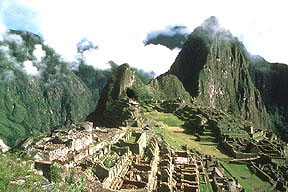This is a drawing of a process which forms mountains on Earth.
Click on image for full size
Mountain Building
Mountains are built through a general process called "deformation" of the crust of the Earth. One example of deformation comes from the process of subduction.
When two sections of the Earth's lithosphere collide, rather than being subducted, where one slab of lithosphere is forced down to deeper regions of the Earth, the slabs pile into each other, causing one or both slabs can fold up like an accordion. This process elevates the crust, folds and deforms it heavily, and produces mountains. Mountain building and mantle subduction usually go together.
This process is illustrated in the figure to the left. The lithospheric slab on the right is subducted, while the force of the collision gradually causes the slab on the left to fold deeply. Along the way, melting of the subducted slab leads to volcano formation.
You might also be interested in:

When two sections of the Earth's lithosphere collide one slab of lithosphere can be forced back down into the deeper regions of the Earth, as shown in this diagram. This process is called subduction.
...more
Volcanoes form when hot material from below risesand leaks into the crust. This hot material, called magma, comes either from a melt of subducted crustal material, which is light and buoyant after melting,
...more
Many kinds of surface features provide evidence of a sliding lithosphere. When two plates move apart, rising material from the mantle pushes the lithosphere aside. Two types of features can form when
...more
Peru's new president, Alejandro Toledo, was sworn in on July 28, 2001. The next day he took part in traditional ceremonies asking for the blessing of the Incan gods. Toledo is himself one of 16 children
...more
Instead of icy-volcanism, the surface of Ganymede reveals a gradual surface deformation remeniscent of the crustal deformation of the Earth. In this case, crustal extension of the surface of Ganymede resulted
...more
On our way from Arica to Iquique, we visited one of the largest human geoglyphs - the Giant of the Atacama. Etched into the side of a solitary mountain, the 393 feet high human figure is one of many depictions
...more
Flying twin-engine light aircraft the equivalent of several trips around the globe and establishing a network of seismic instruments across an area the size of Texas, a U.S.-led, international team of
...more














